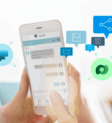Chatbots: AI’s Most Practical Use Case for The Digital Workplace

WHAT DOES A DIGITAL WORKPLACE STAND FOR?
A survey by the SMG/CMSWire and Digital Workplace Group as an industry insight for the 2017 Digital Workplace Experience conference revealed that 95 percent of organizations agree that a digital workplace is important.
There are several definitions of a digital workplace, so it’s really important to understand what it really is. Gartner puts it eloquently, claiming that the Digital Workplace enables new, more effective ways of working; raises employee engagement and agility; and exploits consumer-oriented styles and technologies.
Needless to say, all of these important achievements for an organization and they want to get on the bandwagon as soon as possible. With all of the radical transformations in technology, the digital workplace is undergoing an upheaval of changes. How then does an organization prepare and adapt?
As the current of an issue as it is to digitize your workplace, it’s also important to note that this conversion should be addressed in its entirety, which means technology, process and people – all three contributing factors must be taken into account and accordingly brought together.
Even before we get into the specifics of how chatbots are key to a digital workplace, it should also be noted that a digital workplace is not a destination, but rather a journey. This means your organization must be prepared for constant innovation, improvement and transformation. With that being said, it is also imperative that the digital workplace strategy being employed must take into account that employees are of utmost importance in this journey – organizations must continually provide them with latest technologies and tools required.
Read More: 5 Digital Workplace Trends for 2018.
And that brings us to the discussion of a chatbot.
WHAT ARE CHATBOTS?
A chatbot is really just another software, which is often powered by machine learning and artificial intelligence and can carry human-like conversations. Conversations between the user and a bot happen via a chat interface using textual or auditory methods.
Bots are usually built using a chatbot platform or frameworks, and deployed on messaging apps like Skype, Skype for Business, Slack, Microsoft Teams etc. or virtual assistants like Alexa & Cortana to converse with end-users. Advancements in Artificial Intelligence and its components related to it like Machine Learning and Natural Language Processing (NLP) led to the building of highly intelligent bots with extremely relevant responses in a natural language tone.
The reason chatbots are gaining so much attention from businesses across the world is that they offer a myriad of practical applications for both employees and customers.
THE ROLE OF CHATBOTS IN THE DIGITAL WORKPLACE
Before we begin to discuss the role of chatbots in the digital workplace, it is essential to understand what chatbots can do for your workforce. Chatbots can:
Fetch information
Answer Questions
Push personalized notifications
Complete tasks
If you have watched the famous Marvel movie “Iron Man”, you must be be well acquainted with Tony Stark’s virtual assistant Jarvis and how Tony has him do a lot of groundwork for him like “Do a background check on that person”, “Launch the new missile”, “Connect me with Pepper”, “What is the latest news” etc.
An employee chatbot features similar functionality. Consider these scenarios:
George, a sales employee, wants to know the latest updates on the intranet. He can ask/send a quick natural language question such as, “What’s new?” to his/her intranet chatbot in Slack, Skype for Business etc. and obtain personalized updates.

George is facing issues with his VPN and wants to raise an IT helpdesk ticket, He can simply ask an IT helpdesk chatbot for instructions or raise a ticket to get in touch with a human agent. He doesn’t have to log in to ServiceNow or Jira to complete the action.
George wants to obtain specific information from the CRM or a BI system or a Reporting system. He can skip logging in, filtering dashboards and switching between windows – he simply has to ask the BI chatbot for the details he needs.

George is now wearing a field-sales personnel cap and needs to know if there have been rises or dips in sales. A field-sales chatbot can send personalized alerts so George is immediately notified when action needs to be taken.

George doesn’t know how to apply for a leave. He can simply ask the HR chatbot for instructions and apply by chatting with the bot in the language of his choice.

The greatest benefit that chatbots bring about is ensuring tasks get done in a single interface. There is no time wasted in switching between various apps or any ensuing confusion. George can get his daily tasks done efficiently because he has handed off most of the ‘manual’ work to the chatbot, getting it all done within his actively-used messaging app.
- Chatbots provide a self-service option to employees and reduce their dependency on external IT or HR teams. This contributes towards delivering better employee experience and increased productivity, as well as easier knowledge access and sharing. Think of all time and costs saved! Chatbots are expected to cut business costs by $8 billion by 2022.
- Chatbots provide enormous support to the emerging enterprise mobility. Remote employees can access chatbots to access information or get tasks done across multiple devices anytime and anywhere.
CHATBOTS PRESENT USE CASES ACROSS A RANGE OF DEPARTMENTS.
Take for example, the intranet system of an organization. What always begins with the highest expectations of collaboration and engagement, intranet installation often witnesses dismal adoption rates and eventually being relegated to the job of legacy reference systems or a repository of references. They are not remotely leveraged for their potential of generating interactive engagement across the organization.
This, of course, results in diminished ROI, and leaves employees working remotely void of the collaboration tool they require to stay plugged into the project and be productive in distributed teams. This inability to leverage the intranet’s potential functionality has left businesses rather concerned, as instances of distributed teams rise across the world.
The Gallup’s State of the American Workplace report reveals that “43 percent of Americans said they spent at least some time working remotely last year, up from 39 percent in 2012.”
IT’S THE RIGHT TIME TO CONSIDER CHATBOTS
As you begin your journey towards a digital workplace, we expect that chatbots will obviously figure into your path towards transformation. A bot strategy can help businesses identify the most profitable use case. Unlike other AI technologies, chatbots come with the least privacy and security issues and don’t require many cultural changes. They typically have high adoption rates due to ease of use, and deliver performance improvements rather quickly.
At Acuvate, we leverage our AI-Powered Chatbot Platform – BotCore to build custom bots for enterprises. Our readily available solutions also include:
If you are currently considering building a chatbot or are exploring what a chatbot can do to address your specific business challenges, sign up for a free bot strategy session with one of our AI experts!

Abhishek is the AI & Automation Practice Head at Acuvate and brings with him 17+ years of strong expertise across the Microsoft stack. He has consulted with clients globally to provide solutions on technologies such as Cognitive Services, Azure, RPA, SharePoint & Office 365. He has worked with clients across multiple industry domains including Retail & FMCG, Government, BFSI, Manufacturing and Telecom.






Abhishek Shanbhag